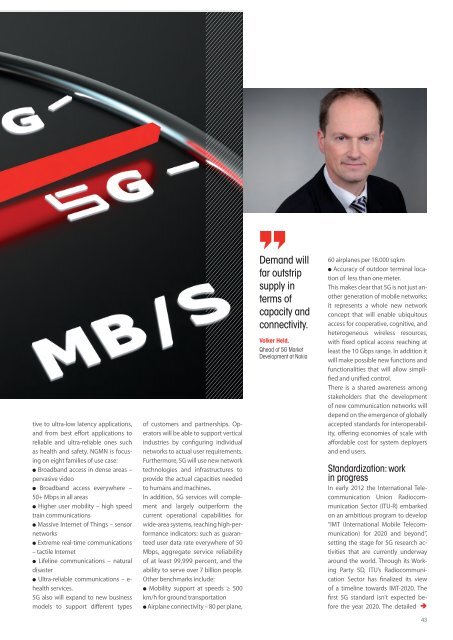Smart Industry 1/2016
Smart Industry 1/2016 - The IoT Business Magazine - powered by Avnet Silica
Smart Industry 1/2016 - The IoT Business Magazine - powered by Avnet Silica
You also want an ePaper? Increase the reach of your titles
YUMPU automatically turns print PDFs into web optimized ePapers that Google loves.
tive to ultra-low latency applications,<br />
and from best effort applications to<br />
reliable and ultra-reliable ones such<br />
as health and safety. NGMN is focusing<br />
on eight families of use case:<br />
● Broadband access in dense areas –<br />
pervasive video<br />
● Broadband access everywhere –<br />
50+ Mbps in all areas<br />
● Higher user mobility – high speed<br />
train communications<br />
● Massive Internet of Things – sensor<br />
networks<br />
● Extreme real-time communications<br />
– tactile Internet<br />
● Lifeline communications – natural<br />
disaster<br />
● Ultra-reliable communications – e-<br />
health services.<br />
5G also will expand to new business<br />
models to support different types<br />
of customers and partnerships. Operators<br />
will be able to support vertical<br />
industries by configuring individual<br />
networks to actual user requirements.<br />
Furthermore, 5G will use new network<br />
technologies and infrastructures to<br />
provide the actual capacities needed<br />
to humans and machines.<br />
In addition, 5G services will complement<br />
and largely outperform the<br />
current operational capabilities for<br />
wide-area systems, reaching high-performance<br />
indicators: such as guaranteed<br />
user data rate everywhere of 50<br />
Mbps, aggregate service reliability<br />
of at least 99,999 percent, and the<br />
ability to serve over 7 billion people.<br />
Other benchmarks include:<br />
● Mobility support at speeds ≥ 500<br />
km/h for ground transportation<br />
● Airplane connectivity – 80 per plane,<br />
Demand will<br />
far outstrip<br />
supply in<br />
terms of<br />
capacity and<br />
connectivity.<br />
Volker Held,<br />
Qhead of 5G Market<br />
Development at Nokia<br />
60 airplanes per 18.000 sqkm<br />
● Accuracy of outdoor terminal location<br />
of less than one meter.<br />
This makes clear that 5G is not just another<br />
generation of mobile networks;<br />
it represents a whole new network<br />
concept that will enable ubiquitous<br />
access for cooperative, cognitive, and<br />
heterogeneous wireless resources,<br />
with fixed optical access reaching at<br />
least the 10 Gbps range. In addition it<br />
will make possible new functions and<br />
functionalities that will allow simplified<br />
and unified control.<br />
There is a shared awareness among<br />
stakeholders that the development<br />
of new communication networks will<br />
depend on the emergence of globally<br />
accepted standards for interoperability,<br />
offering economies of scale with<br />
affordable cost for system deployers<br />
and end users.<br />
Standardization: work<br />
in progress<br />
In early 2012 the International Telecommunication<br />
Union Radiocommunication<br />
Sector (ITU-R) embarked<br />
on an ambitious program to develop<br />
“IMT (International Mobile Telecommunication)<br />
for 2020 and beyond”,<br />
setting the stage for 5G research activities<br />
that are currently underway<br />
around the world. Through its Working<br />
Party 5D, ITU’s Radiocommunication<br />
Sector has finalized its view<br />
of a timeline towards IMT-2020. The<br />
first 5G standard isn't expected before<br />
the year 2020. The detailed<br />
43

















